Comprehensive Review of Personal Locator Beacons for Watersports
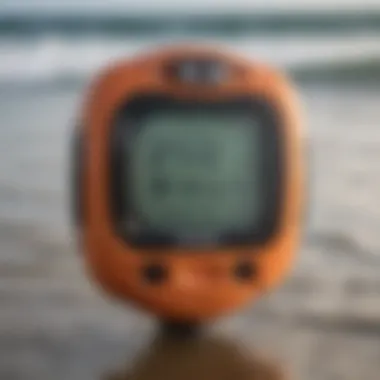
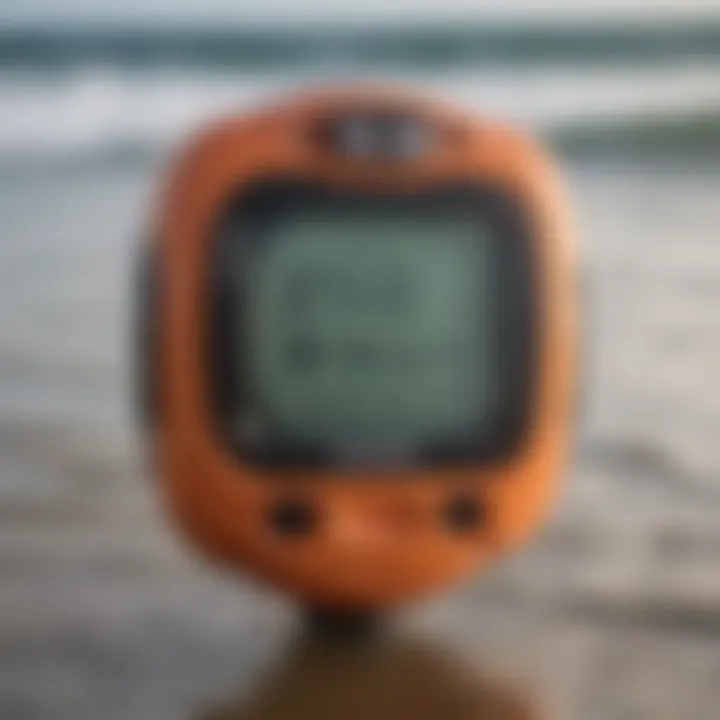
Intro
Water sports come with their fair share of excitement, but safety should never take a back seat. For those who brave the waves or glide across serene lakes, having a Personal Locator Beacon (PLB) can make a world of difference. These devices serve as a lifeline in emergencies, offering a sense of security that can elevate the overall experience of any aquatic adventure.
The modern landscape of watersports demands a clear understanding of the role and functionality of PLBs, especially given the unpredictable nature of water environments. This article digs into the nitty-gritty of PLB reviews, shedding light on their key features, real-world benefits, user experiences, and the expert evaluations that can guide both novices and seasoned enthusiasts alike.
Techniques and Skills
Essential Techniques for Beginners
For beginners venturing into watersports, mastering certain techniques can significantly enhance their experience. First things first, it's crucial to understand how to use a PLB effectively. Here are some fundamentals:
- Familiarize Yourself with the Device: Spend time learning the PLB's functionalities before hitting the water. Know how to activate it in an emergency.
- Regular Testing: Like any piece of tech, ensure that your PLB is in good working order. Perform regular tests to confirm it operates correctly.
- Keep It Accessible: Always have your PLB within arm's reach. If you're in trouble, every second counts.
Another vital skill is understanding the local environment. Each waterway has its own quirks—current strength, tide patterns, and weather conditions. Being attuned to these factors can help you maintain control and make sound judgments.
Advanced Skills for Experienced Watersport Enthusiasts
Seasoned water adventurers should focus not just on personal skill but also on preparedness. Expertise in the field means knowing the ins and outs of advanced navigation and rescue techniques, which can complement a PLB’s utility:
- Navigation Skills: Knowing how to read a chart or using a GPS system properly enhances safety. Your PLB can assist when things go awry, but navigation can prevent emergencies in the first place.
- Emergency Response Planning: Create and practice an emergency response plan. This includes identifying potential hazards that may necessitate using your PLB.
- Team Coordination: If you're out with other enthusiasts, ensure everyone understands their roles in case of an emergency. A well-coordinated effort can be lifesaving.
Equipment and Gear
Must-Have Gear for Each Watersport
While a PLB acts as the guardian angel during aquatic activities, complementary gear makes for a safer experience overall. Here are some essentials to consider:
- Life Vest: Always wear a well-fitted life vest, which not only keeps you buoyant but is also a legal requirement in many areas.
- Emergency Whistle: It may sound basic, but a whistle can be heard far better over water than a voice.
- Flares: Small, portable flares can signal your location in case of an emergency, especially in areas where visibility is poor.
Tips for Selecting the Right Equipment
Choosing the right gear isn’t just about branding or price, it’s about your needs and the environments you’ll navigate. When considering equipment, like your PLB, keep the following tips in mind:
- Consider Environmental Factors: Will the waters be fresh or saltwater? Is there a risk of currents or tides? Evaluate how these can affect your gear selection.
- Compatibility: Ensure that your PLB works with the navigation systems you plan on using. Some models pair well with smartphones or other GPS devices.
- User Reviews and Recommendations: Don’t take everything at face value. Checking user reviews can provide insights that specs and advertisements cannot.
"A well-informed decision can lead not just to enhanced safety but can also enrich the joy that comes with watersports."
The narrative continues to vividly paint a picture of safety as a cornerstone for enjoyable water activities, and it sets the stage for deeper exploration into PLB capabilities, user experiences, and best practices in the subsequent sections.
Understanding Personal Locator Beacons
Personal Locator Beacons (PLBs) serve as a lifeline for anyone venturing into aquatic adventures. Understanding these devices is not just about knowing what they are; it involves grasping how they function and their significance in ensuring safety during watersports. PLBs are particularly useful for those who might find themselves in precarious situations far from help.
Key Aspects of PLBs:
- Emergency Communication: At its core, a PLB is designed to send a distress signal that provides your location to rescue services. This ability transforms moments of panic into a glimmer of hope when every second counts.
- Survivability in Challenging Conditions: Designed to work under extreme circumstances, many PLBs are rugged, waterproof, and equipped to transmit signals even in rough waters.
- User Empowerment: Knowledge of how to effectively use a PLB has a direct relation to safety in emergency scenarios. The intersection of technology and user adeptness is crucial, especially for novices.
The nuances of PLB usage differ vastly among users, from professionals to casual enthusiasts. By delving into the functionality, understanding these can mitigate risks and lead to better preparedness.
Definition and Functionality
A Personal Locator Beacon is a portable electronic device that can alert search and rescue teams in case of an emergency. When activated, it transmits a distress signal via satellite networks to relevant authorities. Essentially, PLBs operate like a beacon—flashing lights in distress, even when visibility is poor.
- Activation: The activation process is quite straightforward. Users merely need to press a button, and within minutes, the signal is sent out.
- Global Coverage: They function globally, which means even in remote areas where traditional communication methods fail, PLBs can still reach out for help. This characteristic is vital for watersport explorers who traverse uncharted territories.
- Battery Life: Most models feature long-lasting batteries and can transmit alerts for several days, ensuring assistance can be sent even after initial distress signals.
The Technology Behind PLBs
Here’s where the magic happens. PLBs utilize intricate technology that combines GPS functionality and satellite communication systems. Hence, it’s not just about sending a signal but doing so with pinpoint accuracy, ensuring that rescuers can locate the individuals in distress.
- GPS Integration: The GPS chips ascertain the user's geographic location, which is then relayed to rescue teams. This tech is key in watersports because terrain and weather patterns can change swiftly, and accurate location data greatly enhances the chance of a successful rescue.
- Satellite Networks: PLBs connect to networks such as the Cospas-Sarsat system, an international satellite-based emergency alert system. This means once the distress signal is activated, it can reach rescue teams whether they are on land, sea, or in air.
"In watersports, every moment matters. A reliable PLB ensures you’re never alone, no matter how far from shore you might stray."
In summary, the importance of comprehending Personal Locator Beacons cannot be overstated. Their design embodies a blend of technology and practicality, transforming potentially perilous situations into encounters navigated with confidence. As one delves deeper into the intricacies of PLBs, the insights gained will undoubtedly bolster both safety and peace of mind during any watersport activity.
Importance of PLB Utilization in Watersports
Personal Locator Beacons (PLBs) are not just gadgets; they play a crucial role in ensuring safety for watersport adventurers. As anyone who's spent time on the water knows, conditions can change faster than you can say "sunny day." That's where the significance of PLB utilization comes into play. These devices can be a game-changer in terms of emergency readiness, serving as a lifeline when the waters get rough and the situation turns dire.
Enhancing Safety Measures
Ensuring safety on the water is vital, and PLBs are an essential tool in achieving that goal. They offer peace of mind by providing direct communication with rescue teams. When a user activates a PLB, a distress signal is sent out, pinpointing their location. This immediate response mechanism allows for a faster rescue, which can mean the difference between life and death.
Using these devices enhances safety measures significantly:
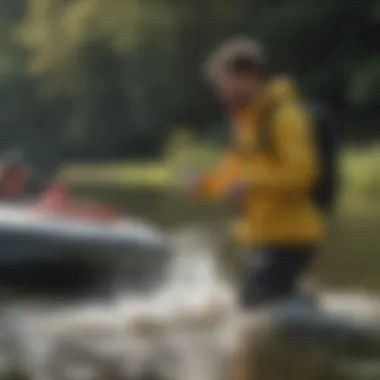
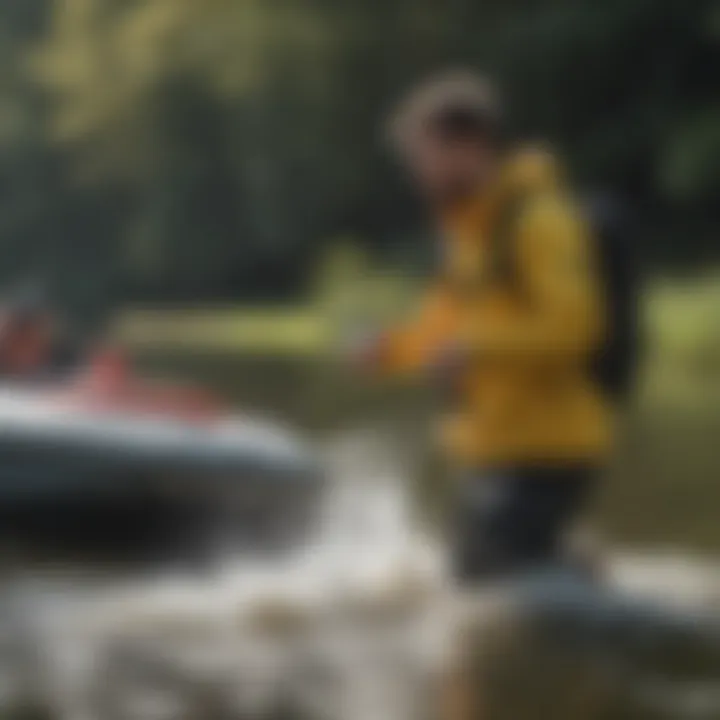
- Accurate Location Tracking: Knowing how to navigate the waters is one thing, but having someone on the outside know where you are is another entirely. PLBs use GPS technology, allowing rescue teams to triangulate your position with remarkable accuracy.
- Reliable Signal Transmission: Unlike mobile phones which can falter when out of range, PLBs operate on a dedicated satellite system, ensuring your call for help isn’t muffled by a weak signal or poor reception.
- User-Friendly Activation: In the heat of the moment, one might forget complicated steps. Most PLBs are designed with simplicity in mind; often, they just need to be pulled from a pouch and activated with a firm press of a button.
By integrating PLBs into your watersport routine, you're not just playing it safe; you’re actively enhancing your safety measures, providing a layer of security that allows you to enjoy your activities with less worry.
Real-Life Emergency Scenarios
Understanding the theoretical benefits of PLBs is important, but real-life situations illustrate their true value. Consider this: a group of kayakers sets out for what’s supposed to be a leisurely afternoon paddle. Suddenly, a sudden storm brews on the horizon, and the winds swell, causing capsizing waves. This is not an exaggerated tale; it happens more than one might hope.
In that pivotal moment, having a PLB means the kayaker can send an SOS with immediate effect. Here are a couple of distress scenarios where PLBs have proven invaluable:
- Capsizing incidents: In studies on maritime safety, many individuals recount stories where their vessel capsized. In each of these accounts, activating a PLB made rescuers aware of not just the general area, but the exact location where assistance was required.
- Medical Emergencies: Imagine someone suffers a medical emergency, like a heart attack or severe injury, far from shore. With a PLB at their side, a rapid alert can be issued, guiding medical teams directly to the scene to provide immediate aid—a monumental factor in increasing survival chances.
Such accounts emphasize that without PLBs, these stories might have ended differently. Their deployment in real-life rescues confirms the necessity and life-saving potential of PLBs as critical safety equipment for any water sport enthusiast.
"Having a PLB was like carrying a safety net; I may not have needed it often, but when the storm hit, it was my lifeline." - A veteran kayaker.
This narrative showcases the real-world implications of using PLBs and underscores how having one on board is no longer just a recommendation; it’s an essential practice that can save lives.
Factors to Consider When Choosing a PLB
When it comes to selecting a Personal Locator Beacon (PLB), there are several critical factors to take into account. Making an informed decision ensures you have the right device for your specific watersport activities, enhancing both safety and peace of mind. Here’s a breakdown of essential elements that should guide your choice.
Size and Portability
One of the first things to think about is size. A PLB should not only be lightweight but also compact enough to be easily stored and carried. For instance, imagine you’re on a kayaking adventure. You don’t want a bulky device weighing you down or taking up all your backpack space. Opting for a smaller, portable model can make a huge difference, as it allows you to keep the beacon close at hand without adding unnecessary weight. Also, consider how you plan to attach it or store it while engaging in your sport. A device with multiple attachment options, like lanyards or clips, tends to be more user-friendly and less prone to being misplaced in a moment of crisis.
Battery Life and Maintenance
Next on the list is battery life. You’ll want a PLB that can run for a long time without needing immediate replacement. Some devices boast impressive battery lives, lasting several years without needing contact replacement. It’s essential to read reviews about reliability, as a low battery in an emergency can be a life-threatening situation. Regular maintenance is another aspect that should not be overlooked. Make it a habit to check the battery status before your trips. Many manufacturers offer simple maintenance tips; ensure you read those because following them can be lifesaving.
Activation Process
Finally, it’s crucial to understand the activation process of the PLB you choose. During a time of duress, you want a device that is straightforward and failsafe to operate. Look for devices that offer a clear way to activate help with minimal steps—ideally a single push of a button is a good feature. Some models even come with protective covers to prevent accidental activation. Familiarize yourself with the activation procedure before hitting the waters; practice it if needed to ensure that you are not fumbling around in an emergency. As the saying goes, "practice makes perfect," so make sure to get comfortable with your device.
Remember: In an emergency, hesitation can cost precious time; being well-prepared is key.
Making the right choice in selecting a personal locator beacon isn’t just about getting the latest model; it’s about understanding how different features can impact your safety and emergency preparedness in the water. Take the time to weigh these considerations, and you’ll be armed with the knowledge necessary to make a sound decision.
Evaluating Popular PLB Models
Evaluating the various Personal Locator Beacon (PLB) models on the market is crucial for watersport enthusiasts who prioritize safety. As watersport activities inherently come with risks, having a reliable means of communication during emergencies is non-negotiable. The market is flooded with a mix of advanced and basic models, which makes thorough evaluation important to ensure that users choose the right tool for their needs.
When assessing these popular models, several elements come into play, including reliability, battery life, user-friendliness, and international coverage capabilities. Each model offers its own set of benefits and drawbacks, which can significantly influence both functionality and user experience.
Choosing the right PLB can mean the difference between life and death in critical situations. Therefore, understanding what distinguishes these models, their strengths, and any potential weaknesses is paramount for every user, from casual adventurers to seasoned professionals.
Detailed Reviews of Top Brands
When discussing detailed reviews of top brands in the PLB realm, it's important to take a closer look at the leading contenders in the industry. Brands such as ACR Electronics and McMurdo have built a reputation for their reliability and effectiveness, while also offering some of the latest advancements in PLB technology.
- ACR ResQLink 400: This device is compact, floatable, and equipped with a powerful GPS chip. It's designed for ease of use, allowing users to activate it with one button in a pinch. Many reviewers praise its quick satellite lock and approximately 24 hours of battery life once activated.
- McMurdo SmartFind G8: A bit more sophisticated, this model employs both GPS and a 406 MHz distress signal, which ensures it can communicate effectively with rescue services regardless of geographical location. User reviews often highlight its capabilities in areas traditionally deemed unreachable.
- Ocean Signal rescueME PLB1: Renowned for its slender design, it easily fits into a pocket or can be attached to a life vest. Lifespan and build quality are often flagged in user ratings as high points.
While the specific features and functionalities of these models are important, one must also consider personal preferences and unique use cases in watersports when selecting a PLB.
Comparison of Features and Costs
A side-by-side comparison provides clarity on how these models measure up against each other in several crucial categories. Below is a summary of some of the key aspects.
| Model | Weight | Battery Life | GPS Lock Time | International Use | Cost | | ACR ResQLink 400 | 4.6 oz | 24 hours | 5-30 seconds | Yes | $299 | | McMurdo SmartFind G8 | 9.5 oz | 48 hours | 2-5 minutes | Yes | $499 | | Ocean Signal rescueME PLB1 | 4.6 oz | 30 hours | 2-5 minutes | Yes | $279 |
The costs of these beacons can vary widely based on features. It's evident that while higher-priced models may offer advanced technology, budget-friendly options also perform admirably. Opting for a higher price tag can sometimes yield a product with better battery life or faster GPS locking, which could be crucial in an emergency.
Ultimately, it's about striking the right balance between capability and budget.
When evaluating a PLB, remember that investing in safety should be top priority. Always consider the specific demands of your watersport activities and choose a model that best aligns with your safety preparedness expectations.
User Experiences and Testimonials
Understanding the experiences of those who have used Personal Locator Beacons (PLBs) provides invaluable insights into their real-world reliability and efficiency. This section digs into the narratives of watersport enthusiasts who have turned to PLBs during their adventures, highlighting critical factors that help potential users assess these devices' value. User testimonials not only showcase effectiveness but also spotlight the emotions and human elements involved in using safety devices.
First-Hand Accounts from Watersport Enthusiasts
When it comes to safety on the water, the stories of individuals who relied on PLBs can serve as powerful testaments. Many enjoy sharing their harrowing or, at times, reassuring experiences. For example, a kayaker named Julie noted that her Beacon was key to her rescue after she capsized in a particularly stormy sea.
"It was terrifying being alone in those choppy waters. But I pressed the button on my PLB, and within minutes, help arrived. I can't stress enough how crucial that little device was for me."
This underscores the lifesaving role PLBs play. Julie's account reflects a common theme among users: the peace of mind that comes with having a reliable device that can alert rescuers when things go awry.
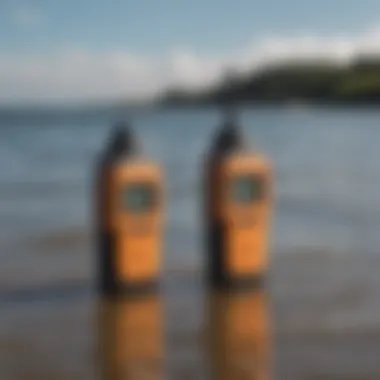
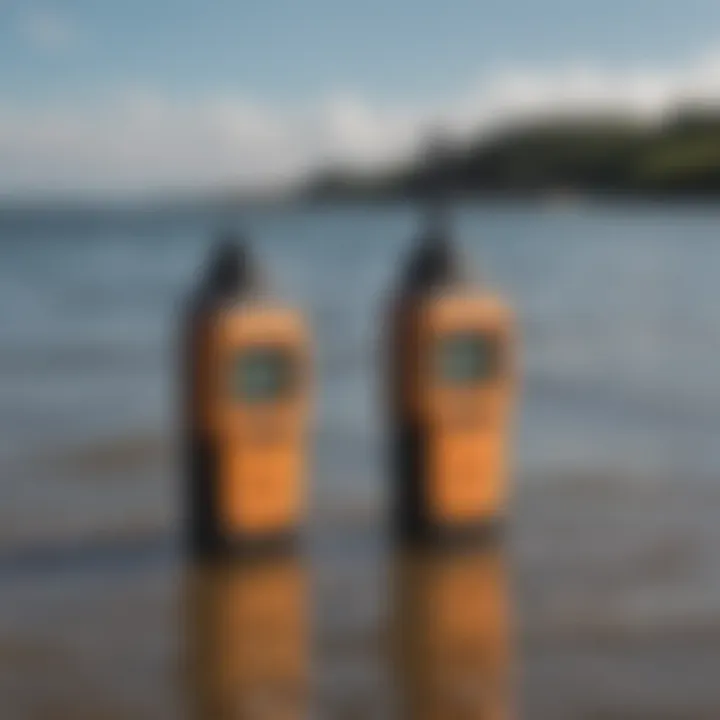
Conversely, there are learning moments that users often recount. Mark, an avid scuba diver, didn't fully understand how to operate his PLB properly. He shared that during a dive trip, he accidentally activated it without a real emergency.
"It's important to know how and when to use your device. I learned the hard way, and thankfully, there were no actual rescue efforts needed, but it did make me realize I needed to read the manual thoroughly!"
Such stories reveal that while PLBs are essential, proper understanding and practice in their use are equally vital. As feedback accumulates, a recurring lesson surfaces: practicing activation techniques can ensure swift action when it matters the most, showing that every adventure on the water comes with a respective learning curve.
Expert Opinions and Recommendations
Expert insights add another layer of credibility to discussions about PLBs. Professionals in the field of watersafety advocate for the incorporation of proper training for PLB users. They emphasize understanding each model's specifications and best practices for activation.
For instance, Dr. Emily Cartwright, a marine safety instructor, argues that reading user manuals and conducting regular functionality tests can significantly enhance safety during watersports. She suggests that users should never underestimate the importance of training with their safety devices.
"A Personal Locator Beacon is only as effective as the person using it. Regularly checking your device and knowing exactly how to operate it is essential, especially in emergency scenarios."
Professionals also encourage users to share their experiences in forums or communities, like those found on platforms such as Reddit or Facebook. This collaboration can help new users learn the nuances from seasoned watersport adventurers, actively shaping the landscape of safety discussions.
A few key recommendations experts commonly express include:
- Attend workshops for practical training on PLB operation.
- Join local watersport clubs where knowledge-sharing can occur.
- Research different PLB models using online reviews and testimonials, focusing on efficiency in specific conditions.
Through shared stories and expert advice, PLBs can gain clarity regarding their significance in the wide world of watersports. By pooling both experiences and professional insights, watersport enthusiasts can make informed choices, ensuring their safety is never left to chance.
Best Practices for Using a PLB
Using a Personal Locator Beacon (PLB) effectively requires more than just purchasing the device and hoping for the best. Taking the time to understand the essential practices can be the difference between a routine day on the water and a potential life-threatening situation. Here, we delve into critical elements that surround the best practices for using a PLB, ensuring that watersport enthusiasts are equipped to make the most of this vital safety tool.
Pre-Trip Checklist
Before embarking on your watersport adventure, it’s crucial to perform a thorough pre-trip checklist concerning your PLB. This will not only give you peace of mind but also could be a lifesaver if an emergency were to arise.
- Device Inspection
- Battery Check
- Communication
- Familiarization
- Environmental Considerations
- Check for any physical damage on the device. Any cracks or water ingress could render it ineffective. A simple visual inspection can help catch issues before they escalate.
- Ensure that the PLB’s battery is fully charged. Many models have self-test features that let you know if the battery is good to go. Don't skip this; a dead battery can be the most frustrating thing in a critical moment.
- Inform a reliable person about your plans. Provide them with the details, including expected return times and locations where you will be. This extra step could expedite search efforts should things go awry.
- Make sure you know how to operate your PLB. Read the manual thoroughly and practice activating it—this could save precious seconds when every moment counts. Many PLB devices have different activation mechanisms; understanding yours is critical.
- Be aware of the area you are venturing into—check for potential challenges that could affect PLB performance, such as dense wooded areas or mountainous regions that might obstruct satellite signals.
"Preparation is the key; a well-prepared adventurer can handle surprises better than most."
Activation Techniques During Emergencies
In the unfortunate event that you need to activate your PLB, understanding the correct techniques can streamline the process, reducing the time required to signal for help.
- Immediate Activation
- Understanding the Device Signal
- Positioning the Device
- Stay Tuned
- Provide Additional Information
- Upon realizing an emergency—be it capsizing in rough waters or encountering sudden exhaustion—activate the PLB immediately. Do not hesitate, as waiting will only diminish your chances of a prompt rescue.
- Know that PLBs send a distress signal when activated. Your specific device might have different procedures; for example, some require pressing a button, while others can be setup to activate upon impact. Knowing what yours does will save time.
- Ensure that your PLB is positioned to maximize visibility. If you are in the water, hold it above your head while ensuring it is free from obstructions to the sky. This will help satellites locate you quickly.
- After activation, avoid wasting your energy by staying still to conserve strength unless immediate movement is necessary for safety. Place your PLB in a location where it won’t get lost or submerged, and wait for rescue personnel to reach you.
- If possible, try to signal any nearby craft or call out to others to make them aware of your situation. In some cases, PLB signals can take time to be picked up. Keeping your voice loud may help in multi-tasking while you wait for help.
By integrating these best practices into your routine, you not only safeguard yourself against potential misadventures in watersports but also increase the odds that any emergency situation can be handled swiftly and efficiently.
The Role of PLBs in Different Watersports
Personal Locator Beacons (PLBs) play a pivotal role in enhancing safety across various watersports. As aquatic activities can be unpredictable, having a reliable communication device can change the tide during emergencies. The significance of PLBs is underscored by their ability to connect users to emergency services, thereby increasing the chances of safe rescues. This section will delve into the specific applications of PLBs in sailing, kayaking, and scuba diving, illustrating how these devices can serve as lifesavers in distressing situations.
Sailing
In the realm of sailing, the vastness of the open water can be both exhilarating and frightening. Conditions can alter in the blink of an eye, and sailors often find themselves alone on the water, sometimes far from any land. Here, the utility of a PLB becomes clearly apparent.
Benefits of PLBs in Sailing:
- Immediate Response: When activated, a PLB sends a distress signal that provides precise location coordinates. This feature is crucial in emergencies where every second counts.
- Simplicity of Use: Many modern PLBs are designed to be user-friendly. Even amidst chaos, a sailor can activate the device with one quick motion.
- Durability Features: Sailors often encounter harsh weather and rough seas. Most PLBs are rugged and designed to withstand such environmental factors, ensuring reliability when it matters most.
The ocean is indifferent, but a PLB ensures that help can find you, no matter how far you are from shore.
Kayaking
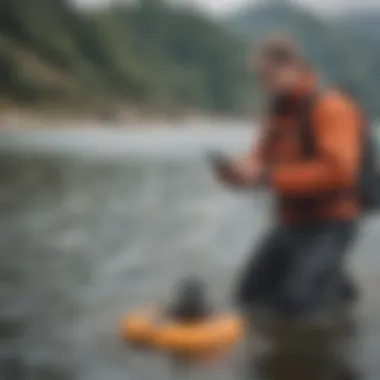

Kayakers usually venture into serene waters, yet they can find themselves in treacherous conditions swiftly, especially in areas with rapid currents or sudden weather changes. A PLB serves as an essential companion for all levels of kayakers, from casual paddlers to seasoned adventurers.
Considerations for Kayakers Using PLBs:
- Lightweight Design: Given the mobilization involved in kayaking, many PLBs are designed to be lightweight and compact, allowing paddlers to carry them effortlessly.
- Visibility: Several PLBs come equipped with strobe lights or reflective surfaces to enhance visibility at night, making it easier for rescue teams to locate the kayaker in distress.
- Water Resistance: The unpredictable splashes and potential capsizes in kayaks mean that a waterproof PLB is indispensable. Such devices are engineered to function perfectly even after immersion in water.
Scuba Diving
Scuba diving, while thrilling, presents its own array of dangers. The underwater environment is not only alien but can also become perilous quickly. In this context, the role of PLBs is critical, especially in deeper waters.
Importance of PLBs for Divers:
- Emergency Beacons: In the event a diver gets separated from their group or experiences a medical emergency, a PLB can provide immediate location tracking for rescuers.
- Altitude Awareness: Many divers tend to forget about the need for safety on the surface, particularly when ascending to the boat or shore. PLBs can act as an additional layer of security, giving divers peace of mind.
- Signal Strength: A PLB's ability to transmit signals from deep underwater can be a lifesaver, sending out a strong signal once the diver reaches the surface.
In summary, PLBs are not merely accessories but vital safety tools that enhance the overall experience in watersports. Their specific applications in sailing, kayaking, and scuba diving highlight their multi-faceted utility, ensuring that enthusiasts can focus on enjoyment while knowing that safety is just an activation away.
Challenges Associated with PLB Use
When engaging in watersports, safety can’t be taken lightly, and Personal Locator Beacons (PLBs) stand at the forefront of those safety measures. However, while these devices are game-changers, they aren't without their challenges. Understanding these challenges is critical for users to make informed decisions and maximize the effectiveness of PLBs in emergency scenarios.
Device Limitations in Remote Areas
One significant hurdle faced by PLB users is their reliability in remote locations. Many watersport activities take enthusiasts far from the nearest shore or assistance. In such isolated areas, the performance of a PLB can be compromised. For instance, satellite connectivity can be weak or entirely absent due to geographical obstructions like mountains or heavy foliage in coastal areas. This can severely limit the beacon's functionality, making it crucial for users to know the coverage limitations of their device before heading out.
"Being miles away from civilization can really shake your confidence; knowing your PLB might not work as intended when you need it most can be quite unsettling."
Users should thoroughly review the manufacturer’s specifications regarding operational range and conditions. It’s also advisable to check satellite coverage maps specific to the region they plan to explore. This proactive approach not only enhances safety but also fosters a sense of preparedness.
User Error and Misconceptions
Another area ripe for challenge stems from user error and widespread misconceptions about how PLBs function. Some people might assume that pressing the activation button is a cure-all, enabling instant rescue. However, it’s not that simple. For instance, a common blunder is not ensuring that a PLB is correctly registered with the relevant authorities. Failing to do so can lead to confusion in rescue operations, wasting precious time that could otherwise save lives.
Moreover, some users might not fully understand the battery life limitations of their devices. A PLB might look perfect on paper until you discover it’s run out of juice just when you need it most. Therefore, regularly checking and maintaining the device is paramount.
- Key Misconceptions
- Believing that PLBs are infallible in all conditions.
- Underestimating the importance of registration.
- Ignoring routine maintenance checks.
Educating oneself and others about PLBs is vital for fostering a culture of safety in watersports. Workshops, online forums, and community groups can be excellent resources for learning and sharing experiences. Engaging with resources such as Reddit or Facebook can expose users to real-world examples of PLB usage and misconceptions around them.
In summary, while Personal Locator Beacons play an essential role in enhancing safety during aquatic adventures, users must navigate these challenges thoughtfully to ensure they function effectively when it truly matters.
Future Developments in PLB Technology
The world of Personal Locator Beacons (PLBs) is not static; it is evolving at a pace that matches the demands of modern watersports. As water activities gain in popularity, the integration of advanced technology becomes a crucial element in enhancing safety measures for users. Understanding the future developments in PLB technology is essential not just for users who want to be prepared but also for manufacturers and safety personnel who aim to improve aquatic safety overall.
Advancements in GPS and Communication
When looking ahead, one of the most significant areas of progression lies in GPS technology and communication systems. Current PLBs often rely on satellite systems that, while reliable, could become obsolete as satellite technology advancements accelerate. Next-gen PLBs are expected to utilize multi-constellation GNSS receivers, allowing for improved accuracy in positioning. Notably, combining signals from multiple systems, such as GPS, GLONASS, and Galileo, enhances tracking precision, meaning users can share their locations with greater reliability.
Moreover, the burgeoning field of real-time communication is set to be a game changer. Future PLBs may allow users to send two-way messages, enabling them to communicate their status or coordinate rescue operations more effectively. This interactivity can prove pivotal in crisis situations where every second matters. Imagine a scenario where a kayaker can describe their condition instead of waiting silently for help. Such options could not only save lives but also reduce the anxiety often associated with emergencies in isolated conditions.
Emerging Trends in Safety Devices
As the demand for safety devices increases, we are witnessing a wave of innovation that likely will redefine what we expect from PLBs. One noticeable trend is the integration of wearable technology. Manufacturers are exploring designs that allow PLBs to be incorporated into wristbands or life jackets, making it easier for users to carry them without the fear of losing the device. This seamless integration may encourage a higher adoption rate among those less inclined to carry traditional beacons.
Another emerging trend concerns the increasing use of smart technology within PLBs. This could manifest in various ways, from incorporating smartphone connectivity to features that allow devices to connect to the Internet of Things (IoT). Such advancements can empower users by providing them access to their beacon's status or battery life right from their phones, ensuring they are always prepared before heading into the water.
"The future of PLBs is not just about response; it's about prevention and real-time awareness."
Finally, as sustainability becomes a prominent concern across all sectors, the development of PLBs powered by solar technology or energy-efficient components will likely take center stage. Batteries are often the Achilles’ heel of electronic devices; hence, finding alternate energy sources will reduce waste while also increasing device longevity.
With these advancements in mind, the landscape of PLB technology appears bright. As manufacturers continue to innovate, users can expect devices that not only meet their safety needs but also fit seamlessly into their aquatic adventures.
Culmination
Diving into the final section of this extensive analysis on Personal Locator Beacons (PLBs) and their role in watersports safety, it is crucial to highlight the main takeaways and implications underscored throughout the article. PLBs are not merely gadgets; they act as pivotal lifelines for individuals engaged in activities ranging from kayaking to scuba diving. Their functionality, while often taken for granted, can be the difference between smooth sailing and a perilous situation in challenging waters.
Recap of Key Takeaways
- Safety First: The fundamental purpose of PLBs is to enhance safety for watersport enthusiasts. The ability to send distress signals significantly boosts personal safety in remote or extreme environments.
- Technology Matters: As discussed, the technology behind PLBs has evolved, featuring advancements in GPS and communication. Choosing a model that adheres to the latest standards can affect reliability during a distress call.
- User Awareness: A recurring theme has been user error, where misconceptions about PLB functionalities can lead to critical mistakes during emergencies. It's essential for users to be fully informed about how their device operates and to undergo regular drills or practices.
- Future Developments: The article also touched on advancements in technology, including the emergence of new safety devices. Staying informed on these developments can give water sports practitioners an edge in ensuring safety.
- Personalization is Key: Every watersport has unique challenges. Therefore, selecting a PLB that aligns with the specific activity is vital. Whether it’s sailing on open seas or paddling through rugged rapids, the right PLB can enhance safety markedly.
Final Thoughts on PLBs for Watersports Safety
Personal Locator Beacons serve as essential tools in the arsenal of safety measures for watersport adventurers. While the thrill of exploring the open water cannot be overstated, it brings with it inherent risks. PLBs furnish a layer of assurance that helps to alleviate some of those unknowns.
As the watersports community continues to grow, so does the need for proactive safety measures. The importance of thorough research and familiarization with a chosen PLB cannot be overlooked. Practitioners must consider not only the technical specifications of these devices but also account for their own habits and predispositions in emergency scenarios. Ignorance can be perilous, and knowledge truly is power in these situations.
In essence, investing in a reliable Personal Locator Beacon and knowing how to use it effectively can offer peace of mind, enabling watersport enthusiasts to focus on what really matters—enjoying the exhilarating beauty of the aquatic world.
"Safety doesn’t happen by accident; it is a choice made by everyone involved."
In walking away from this article, the hope is that water sports enthusiasts will take the lessons laid before them and prioritize their safety as they pursue their passions, armed with the knowledge of what a well-selected PLB can do.







